Drink GOAT MILK!
Are You Kidding Me?
By Alice Osborne
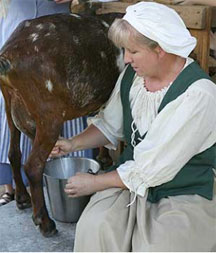
Nope, I’m not kidding. Here’s why: It is nutrient dense and calorie skinny. Unlike cow's milk there is no need to homogenize goat's milk. While the fat globules in cow's milk tend to separate to the surface, the globules in goat's milk are much smaller and will remain suspended in solution. When individuals have sensitivity to cow's milk, goat's milk can sometimes be used as an alternative.
Goat's milk is a very good source of calcium and the amino acid tryptophan. It is also a good source of protein, phosphorus, riboflavin (vitamin B2) and potassium. Perhaps the greatest benefit of goat's milk, however, is that some people who cannot tolerate cow's milk are able to drink goat's milk without any problems. It is not clear from scientific research studies exactly why some people can better tolerate goat's milk.
Other research has found some anti-inflammatory compounds (short-chain sugar molecules called oligosaccharides) to be present in goat's milk. These oligosaccharides may make goat's milk easier to digest, especially in the case of compromised intestinal function.
 In animal studies, goat's milk has also been shown to enhance the metabolism of both iron and copper, especially when there are problems with absorption of minerals in the digestive tract. These factors and others are likely to play an important role in the tolerability of goat's milk versus cow's milk. Allergy to cow's milk has been found in many people with conditions such as recurrent ear infections, asthma, eczema, and even rheumatoid arthritis. Replacing cow's milk with goat's milk may help to reduce some of the symptoms of these conditions.
In animal studies, goat's milk has also been shown to enhance the metabolism of both iron and copper, especially when there are problems with absorption of minerals in the digestive tract. These factors and others are likely to play an important role in the tolerability of goat's milk versus cow's milk. Allergy to cow's milk has been found in many people with conditions such as recurrent ear infections, asthma, eczema, and even rheumatoid arthritis. Replacing cow's milk with goat's milk may help to reduce some of the symptoms of these conditions.
Besides averting allergies, the abundalife.com website explained something else: If you have been around farms, you would notice goats are much more flexible and limber than cows. They can climb and do things that are amazing, such as getting up onto the roofs of barns and houses. You have to wonder HOW that is possible. The reason for this is that goats are a bioorganic sodium animal, while cows are a calcium animal.
Bioorganic sodium in known in Naturopathic Medicine as the youth element. Arthritis a “given” of old age. It is a lack of this essential mineral that brings on the symptoms of old age. The highest sources of bioorganic sodium is found in goat milk and sweet goat whey. Goat milk contains this mineral. It is the sodium that keeps the goats young, active, flexible, and limber all of their lives. There are no “old goats” in the human sense. They can climb, jump, leap, and walk all of their lives because bioorganic sodium is the joining mobilizing material that makes this possible. Now there’s food for thought (dopey pun intended).
 The list of reasons for including goat’s milk in the diet can truly go on, but suffice it to say, it’s an amazing food that ought to be given more consideration. If goat’s milk interests you, here are a couple recipes I like that you might want to try:
The list of reasons for including goat’s milk in the diet can truly go on, but suffice it to say, it’s an amazing food that ought to be given more consideration. If goat’s milk interests you, here are a couple recipes I like that you might want to try:
Chocolate Nutty Fudge
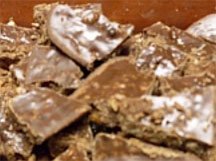 ½ C unsweetened cocoa powder
½ C unsweetened cocoa powder1 C goat milk
2 C sugar
1 C chopped pecans
1/4 C butter
1 tsp vanilla extract
Mix the cocoa powder, sugar and milk together in a pan. Heat on medium to medium-high heat, stirring to be sure the sugar is completely dissolved. Bring to a slow boil, and cook until the mixture reaches a soft ball stage, or 234° F. Stir frequently to prevent sticking.
Remove from heat and stir in the butter, pecans and vanilla extract. Beat by hand until the mixture becomes thick and glossy. Spread into a greased 8" x 8" pan. Cut into squares when cool, or slide the entire square out and break into pieces for a truly homemade appearance.
CAJETA (pronounced cah-heh-tah) is a delicious, sweet Mexican caramel sauce made from goat milk. (I found this recipe on the everything-goat-milk.com website.)
It can be used in practically any way you would normally use caramel, such as for topping ice cream, dipping apples, or topping cookies or cake. My family's favorite is to eat it with a spoon out of the bowl!
All kidding aside — if you plan to use your freshly made cajeta for a special dessert, be sure to hide it from the family, or be prepared to stand guard in the kitchen to prevent it from disappearing prematurely!
The basic recipe is delicious as is, but you can also add flavorings for a special taste. Flavorings should be added after the mixture has cooked — otherwise, you'll cook most of the flavor out before it's finished!
Consider trying a variety of flavors (believe me, you’ll be making this a lot): vanilla extract, maple flavoring, almond extract, rum or rum extract.
Cajeta is made by reduction and caramelization of a milk and sugar mixture.
Cajeta
 You will need:
You will need:1 quart goat milk
1 cup sugar
1/4 tsp. baking soda
1 1/2 Tbsp. cornstarch (Optional, for thicker syrup. The recipe will also work without it.)
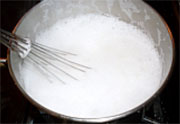 Begin by stirring the baking soda and cornstarch into a small amount of the milk, being sure to completely dissolve any lumps. Pour the remainder of the milk into a pot, and add the sugar, stirring to dissolve. Finish by adding the baking soda mixture.
Begin by stirring the baking soda and cornstarch into a small amount of the milk, being sure to completely dissolve any lumps. Pour the remainder of the milk into a pot, and add the sugar, stirring to dissolve. Finish by adding the baking soda mixture.
 Bring to a boil over medium to medium-high heat, stirring constantly. Adjust the heat setting as needed to maintain a steady boil, without allowing the mixture to boil over. Continue stirring.
Bring to a boil over medium to medium-high heat, stirring constantly. Adjust the heat setting as needed to maintain a steady boil, without allowing the mixture to boil over. Continue stirring.
The bad news is that the process is not a short one — you will need to dedicate approximately 45 minutes to an hour to stirring and monitoring the milk. The good news is that the heat releases that wonderfully unique goat milk smell that you can enjoy inhaling during the work!
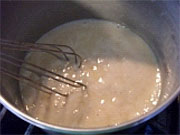 As the mixture thickens, it will begin to take on a caramel color. It's very important that you continue to stir constantly at this stage, or it may begin to stick to the bottom and burn.
As the mixture thickens, it will begin to take on a caramel color. It's very important that you continue to stir constantly at this stage, or it may begin to stick to the bottom and burn.
You can continue cooking until it reaches the desired consistency — whether you want it thin enough to pour, like a caramel sauce, or thicker, like a candy. Remember, though, to compensate for the fact that the sauce will thicken as it cools.
When you're happy with the result, remove from heat and pour into a jar or bowl to cool. Use warm, or refrigerate for later. And, remember to padlock that refrigerator if you plan to use it later!
You can see from the picture below that our original quart of milk produced about 1 cup of sauce, so you can adjust the ingredient amounts accordingly. Just like with goat cheeses, cajeta has that very subtle, wonderful flavoring imparted by the "goaty" fatty acids that sets it apart from caramel made from cow's milk.
And here are a couple tips and a “gift from the kitchen idea”:
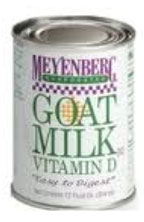 Since the milk is cooked, canned goat milk works just fine for making cajeta. So, you may want to save your fresh goat milk for a recipe where the taste will be affected more.
Since the milk is cooked, canned goat milk works just fine for making cajeta. So, you may want to save your fresh goat milk for a recipe where the taste will be affected more.
Save time by making a large batch and canning the extra. Boil the canning jars, lids and rings for ten minutes. Leave in the hot water until the cajeta is ready. Remove the canning supplies with tongs, and pour the hot caramel into the jars. Wipe away any drips from the openings of the jars, and close with the lids and rings. Cover the jars with a heavy towel and leave undisturbed until the lids seal (you'll hear a loud "pop").
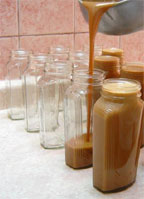 Finally, need a gift for the person who has everything? Bet they don't have a jar of homemade goat milk caramel! Use decorative jars for canning in tip #2, and tie a ribbon and note around the top to make a gift they'll never forget.
Finally, need a gift for the person who has everything? Bet they don't have a jar of homemade goat milk caramel! Use decorative jars for canning in tip #2, and tie a ribbon and note around the top to make a gift they'll never forget.

Contribute to the Cook'n Club!
DVO would love to publish your article, prose, photography and art as well as your cooking, kitchen and nutrition tips, tricks and secrets. Visit the Newsletter Submission / Win Win for All section in our Forum for more information and details.

